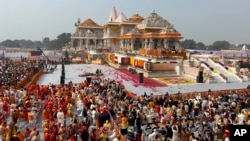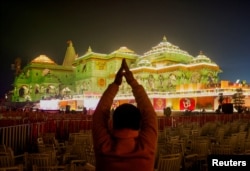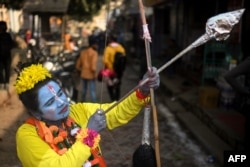Indian Prime Minister Narendra Modi has opened part of a hotly disputed Hindu holy building in the northern city of Ayodhya. The temple stands at the former site of a 16th-century Islamic holy building that Hindu mobs tore down 30 years ago.
Modi’s Bharatiya Janata Party and other Hindu nationalist groups say the opening of the Lord Ram temple is central to their goal of reclaiming Hindu pride after centuries of suppression. Modi and his supporters hope the move will help the prime minister win a record third straight term in elections expected this spring.
But critics accuse Modi of opening the temple too early, as much of the structure remains unbuilt. Opponents say the partial opening was a political act to gain voter support.
And experts say the government-led opening ceremony marks a critical moment in India's history. They argue it demonstrated the weakening line between religion and state under Modi’s leadership. India's founders considered the separation of religion and government to be a critical policy for national unity.
Modi opens Lord Ram Temple
On Monday, the prime minister, dressed in traditional clothing led the ceremony as Hindu clergy chanted hymns inside the temple.
Nearly 7,500 people, including leading industrialists, politicians and movie stars, attended the event. A military helicopter flew over the site dropping flower petals on the crowd below.
“Our Lord Ram has arrived after centuries of wait,” Modi said in a speech after the ceremony, receiving applause from thousands of attendees. He said the temple was built after “countless sacrifices” and is a testament to a rising India “breaking the shackles of slave mentality.”
“January 22, 2024, is not merely a date but marks the dawn of a new era,” Modi said.
Modi's government turned the event into a national celebration by organizing live screenings across the country and closing offices for half a day. Saffron flags — the color of Hinduism — flew in the streets of several cities. Government party workers had gone house to house in those cities to present religious papers to residents.
Television news channels ran nonstop coverage of the event. Some movie theaters broadcast it live with complimentary popcorn. Many states declared the day a public holiday. In a rare step, stock and money markets were closed for the day.
Modi has been the face of a new mix of religion and politics in India. Ahead of the temple opening, he set the tone by visiting numerous Ram temples over 11 days as part of a Hindu ritual.
Hindus from across the country arrived to celebrate the opening. Groups of them danced to religious songs playing from speakers along roads covered with flowers. Some 20,000 security personnel and more than 10,000 security cameras were deployed.
Officials say the temple, a three-level structure made of pink sandstone, is now open to the public. They expect 100,000 people to visit every day.
“I am here to see history unfolding before our eyes. For centuries, the story of Lord Ram has resonated in the hearts of millions,” said Harish Joshi, who arrived in the city from Uttarakhand state four days before the ceremony.
Controversy
But not all are celebrating. Four important Hindu religious leaders refused to attend. They said opening an unfinished temple violates Hindu scripture. Some top leaders from India’s main opposition Congress Party also boycotted the event, with many accusing Modi of using the temple for political gain.
Neighboring Pakistan said a temple built on the site of a destroyed mosque would remain a blot on India’s democracy.
“There is a growing list of mosques (in India) facing a similar threat of desecration and destruction,” Pakistan’s Foreign Ministry said in a statement. It urged the international community to help save historic Islamic sites in India from “extremist groups” and ensure that minority rights are protected.
The estimated cost of building the temple is $217 million, all provided by public donations of money. The temple site spreads over almost 3 hectares, on top of the ruins of the Babri Mosque. In 1992, Hindu mobs attacked and destroyed Babri. They claimed it was built on temple ruins marking the birthplace of Lord Ram.
The mosque's destruction led to bloody riots across India that killed 2,000 people, mostly Muslims.
The dispute officially ended in 2019 when India’s Supreme Court called the mosque’s destruction “an egregious violation” of the law. Still, the court ruled that the site would go to Hindus. The ruling provided another piece of land to go to Muslims.
At least three historical mosques in northern India are involved in court disputes brought by Hindu nationalists. They say temple ruins lie beneath the mosques.
Hindu nationalists have also taken action in Indian courts to seek ownership of hundreds of historic mosques.
I’m Caty Weaver. And I’m Andrew Smith.
The Associated Press reported this story. Caty Weaver adapted it for VOA Learning English.
________________________________________
Words in This Story
shackle – n. something that restricts or prevents free action
screening – n. a showing of a motion picture
resident – n. one who lives in a place
ritual – n. the established form for a religious ceremony
scripture – n. the holy writings of a religion
blot – n. a mark of reproach : moral flaw
desecration – n. a disrespectful, irreverent, or outrageous treatment of something
egregiously – adv. notably bad
Our comment policy is here.












Forum